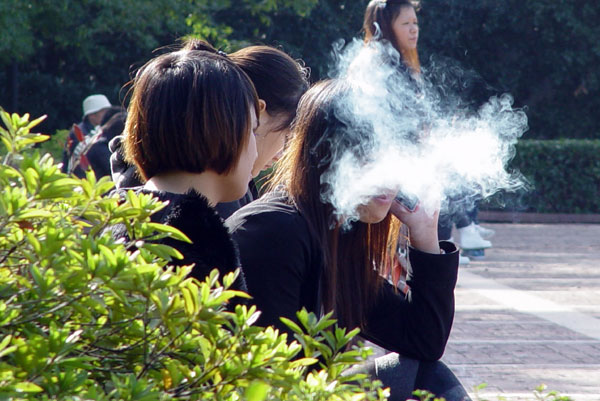Smoking threatens young women
By Shan Juan (China Daily) Updated: 2012-11-08 03:50Secondhand exposure can harm mothers and their babies
Nearly two-thirds of reproductive-aged women on the Chinese mainland are routinely exposed to secondhand tobacco smoke at home, and more than half are routinely exposed at their workplaces, according to a survey by organizations including the World Health Organization.
The data were included as part of the Global Adult Tobacco Survey, with the China content produced in 2010 by the Chinese Center for Disease Control and Prevention, the United States CDC and the WHO.
 |
|
A woman is obscured by a cloud of smoke as she enjoys a cigarette alongside a group of non-smokers in a park in Wuhan, capital of Hubei province, on Sunday. CHU LIN / FOR CHINA DAILY |
"Tobacco use and secondhand smoke exposure in reproductive-aged women can cause adverse reproductive health outcomes, such as pregnancy complications, fetal growth restriction, pre-term delivery, stillbirths and infant death," said Michael O'Leary, WHO representative in China.
According to the findings, exposure to secondhand smoke among women aged 15 to 49 years old on the Chinese mainland is among the highest of the 14 low- and middle-income countries surveyed, such as Bangladesh, India and Mexico.
Also, women in rural areas of the country are more affected, where almost three out of four are exposed to secondhand smoke at home, compared to more than half in urban areas, the results showed.
Yang Jie, deputy director of China CDC's tobacco control office, said: "Women and children are most susceptible to secondhand smoke but worse, most of them choose to tolerate it."
Statistics from the Ministry of Health show that there are more than 300 million smokers on the Chinese mainland and approximately 100,000 people die from exposure to secondhand smoke each year. At least 1 million die from smoking-related diseases annually.
"The Chinese government should take action immediately to address this, particularly to protect women from this health hazard," said Yang Gonghuan, deputy director of the non-governmental China Association on Tobacco Control.
The female smoking rate stands at 2.6 percent on the Chinese mainland, relatively low compared to other places worldwide.
But among young women, particularly those working in cities, that can reach 16 percent in some regions, she added.
Yang is a supporter of banning smoking in public places, and suggests the government also introduce other measures such as printing graphic warnings on cigarette packs about the dangers of smoking, banning tobacco advertising, and offering free advice on stopping smoking.
Other survey findings showed the male smoking rate reached 54 percent on the mainland, second worldwide only after Russia, where 60 percent of men light up.
In response, the Russian government has just passed a bill banning tobacco ads and smoking in public places.
"The Chinese government should follow suit — such measures provide countries with far-reaching and long-term benefits for public health and chronic disease prevention," Yang noted.
She said in recent years China has made efforts at controlling smoking, "but they are far from enough", she added.
In May, China's Ministry of Health released its first report on the hazards of smoking, which outlined the hazards of tobacco use, the ill effects of secondhand smoke, and emphasized the importance of stopping smoking.
In September, the ministry and the US Department of Health and Human Services launched the China-US Partnership on Smoke-free Workplaces, which encourages more organizations to implement smoke-free policies and extend 100 percent smoke-free protection to all indoor workplaces, public transport and indoor public places.
Howard Koh, assistant health secretary of the US department, said the initiative would not only provide a platform for a healthier workforce, but help lead to a healthier environment among the community at large.
Contact the writer at shanjuan@chinadaily.com.cn
- New technology to encourage Chinese 'medical tourists' to Australia
- Xi says it's time for philosophy to flourish
- Top legislator foresees bright future for SAR
- New app to guide visually disabled
- Father and son poisoned by disinfectant in McDonald's drink
- Chinese in their 40s the most enthusiastic about Shanghai Disneyland
- Supply-side reform should be pushed resolutely, says Xi
- Rail capacity boosted under new operational plan
- Media mogul buys Song Dynasty letter for $31.7m
- China becomes No 1 in voluntary organ donations in Asia








